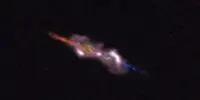A long-forgotten tectonic plate that formerly supported what is now the South China Sea has been uncovered 20 million years after it vanished.
The plate is only known from a few granite fragments found in Borneo’s mountains and the ghostly relics of its massive slab discovered deep in the Earth’s mantle. It used to be one-quarter the size of the Pacific Ocean. Scientists have dubbed it the “Pontus plate” because it once resided beneath an ocean known as the Pontus Ocean.
“It’s surprising to find remnants of a plate that we just didn’t know about at all,” said Suzanna van de Lagemaat, a doctorate candidate at Utrecht University in the Netherlands.

Van de Lagemaat and her colleagues began by investigating the Pacific plate beneath the Pacific Ocean. Because the crust of oceanic plates is denser than that of continental plates, oceanic plates are driven beneath continental plates in a process known as subduction and disappear. However, boulders from a missing plate are occasionally integrated into mountain-building activities. These relics can provide information on the location and formation of old plates.
While conducting fieldwork in Borneo, the researchers were looking for fragments of one of these old missing plates, known as the Phoenix plate. Scientists may examine the magnetic properties of rocks to determine when and where they developed, according to van de Lagemaat; the magnetic field that surrounds Earth becomes “locked in” to rocks when they form, and that magnetic field varies with latitude.
When the researchers investigated the rock they’d obtained in Borneo, they discovered something odd.
“This latitude didn’t fit with the latitude we got from the other plates that we already knew about,” van de Lagemaat told the BBC.
She utilized computer models to analyze the geology of the region over the previous 160 million years to solve the mystery. The plate reconstruction revealed a blip between what is now South China and Borneo – an ocean that was previously considered to be supported by another ancient plate known as the Izanagi plate was not on that plate. Instead, the Borneo rocks fit into that enigmatic gap.
The researchers determined that the location was inhabited by a previously unknown plate, which van de Lagemaat and her colleagues dubbed the Pontus plate.
The reconstruction, which was published in the journal Gondwana Research on September 29th, suggests that the Pontus plate developed at least 160 million years ago but was most likely much older. (The Borneo rock samples date back 135 million years.) It was once massive, but it dwindled progressively over time, eventually being forced under the Australian plate to the south and China to the north, and eventually disappearing 20 million years ago.
Decades of investigation from the same lab revealed hints of the Pontus plate. The imaging of Earth’s middle layer, the mantle, where the subducted crust ends up, was the focus of that study. It revealed a massive slab of crust of unknown provenance, but scientists at the time had no means of knowing where it came from, according to van de Lagemaat. This crust is clearly what’s left of the Pontus plate.
















